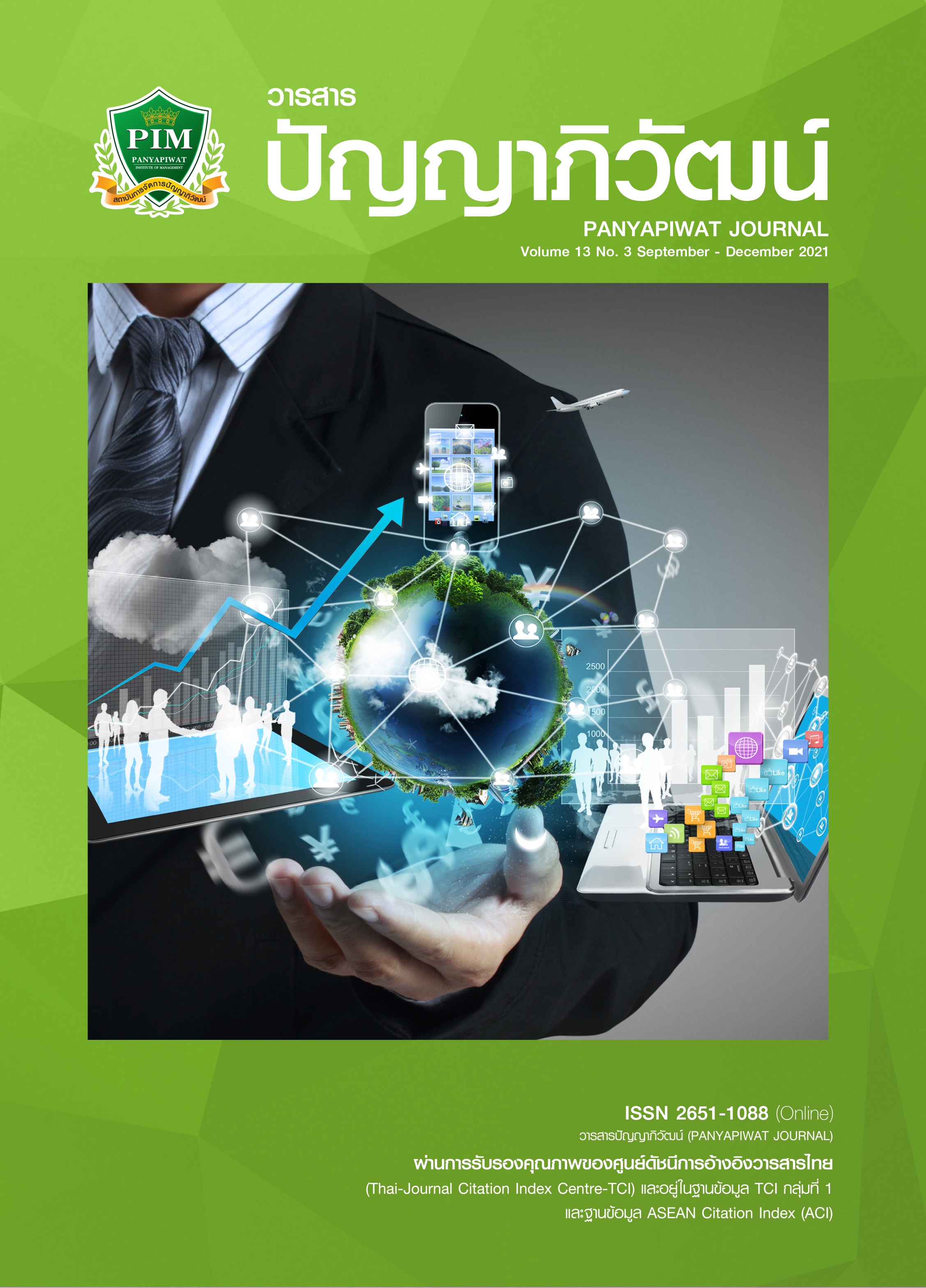การพัฒนาบทเรียน e-learning ควบคู่กับการใช้งาน Google Classroom Applications เรื่อง พระราชบัญญัติคอมพิวเตอร์
Main Article Content
บทคัดย่อ
การวิจัยครั้งนี้มีวัตถุประสงค์เพื่อ 1) พัฒนาและหาประสิทธิภาพของบทเรียน e-learning ควบคู่กับ การใช้งาน Google Classroom Applications เรื่อง พระราชบัญญัติคอมพิวเตอร์ 2) เปรียบเทียบผลสัมฤทธิ์ ทางการเรียนของนักศึกษาระหว่างก่อนเรียนกับหลังเรียนด้วยบทเรียน e-learning ควบคู่กับการใช้งาน Google Classroom Applications เรื่อง พระราชบัญญัติคอมพิวเตอร์ และ 3) ศึกษาความพึงพอใจของนักศึกษาต่อบทเรียน e-learning ควบคู่กับการใช้งาน Google Classroom Applications เรื่อง พระราชบัญญัติคอมพิวเตอร์ กลุ่มตัวอย่างคือ นักศึกษาสถาบันอุดมศึกษาเอกชนแห่งหนึ่ง ชั้นปีที่ 1 ปีการศึกษา 2562 ที่ลงทะเบียนเรียน วิชา SC60103 การใช้โปรแกรมประยุกต์ในองค์กรสมัยใหม่ จำนวน 30 คน ด้วยการเลือกแบบเจาะจง การวิเคราะห์ ข้อมูลใช้ค่า E1/E2 โดยตั้งค่าเป้าหมาย E1 = 80 และ E2 = 80 ค่าเฉลี่ย ส่วนเบี่ยงเบนมาตราฐาน Paired samples t-test และการวิเคราะห์เนื้อหา
ผลการวิจัยพบว่า 1) ประสิทธิภาพของบทเรียน e-learning ควบคู่กับการใช้งาน Google Classroom Applications ที่สร้างขึ้น ได้ค่าเท่ากับ 83.5/85.3 มีคุณภาพอยู่ในเกณฑ์ดี ( = 4.28) 2) ผลสัมฤทธิ์ทาง การเรียนของนักศึกษาหลังเรียนสูงกว่าก่อนเรียน อย่างมีนัยสำคัญทางสถิติที่ระดับ .05 และ 3) ความพึงพอใจ ของนักศึกษาต่อบทเรียน e-learning ควบคู่กับการใช้งาน Google Classroom Applications อยู่ในระดับดี (
= 4.03)
Article Details
“ข้าพเจ้าและผู้เขียนร่วม (ถ้ามี) ขอรับรองว่า บทความที่เสนอมานี้ยังไม่เคยได้รับการตีพิมพ์และไม่ได้อยู่ระหว่างกระบวนการพิจารณาลงตีพิมพ์ในวารสารหรือแหล่งเผยแพร่อื่นใด ข้าพเจ้าและผู้เขียนร่วมยอมรับหลักเกณฑ์การพิจารณาต้นฉบับ ทั้งยินยอมให้กองบรรณาธิการมีสิทธิ์พิจารณาและตรวจแก้ต้นฉบับได้ตามที่เห็นสมควร พร้อมนี้ขอมอบลิขสิทธิ์บทความที่ได้รับการตีพิมพ์ให้แก่สถาบันการจัดการปัญญาภิวัฒน์หากมีการฟ้องร้องเรื่องการละเมิดลิขสิทธิ์เกี่ยวกับภาพ กราฟ ข้อความส่วนใดส่วนหนึ่งและ/หรือข้อคิดเห็นที่ปรากฏในบทความข้าพเจ้าและผู้เขียนร่วมยินยอมรับผิดชอบแต่เพียงฝ่ายเดียว”
เอกสารอ้างอิง
Department of Science Service. (2015). What is Cloud Computing? Retrieved June 23, 2018, from http://lib3.dss.go.th knowledge/bsti-6-2558-cloud.pdf
Gartner. (2013). Gartner Says Worldwide Public Cloud Services Market to Total $131Billion. Retrieved June 23, 2018, from https://www.gartner.com/en/newsroom/press-releases/2017-02-22-gartner-says-worldwide- public-cloud-services-market-to-grow-18-percent-in-2017
Kongrugsa, N. (2014). Teaching Management and Cloud Computing 21st Century. Bangkok: Journal of Vocational and Technical Education King Mongkut’s University of Technology North Bangkok, 4(7), 52-59. [in Thai]
Kuder, G. & Richardson, M. W. (1937). The Theory of Estimation of Test Reliability. Retrieved May 19, 2018, from https://www.scirp.org/reference/ReferencesPapers.aspx?ReferenceID=1342881
Pinyoanantapong, B. (2012). Educational Measurement and Evaluation. Bangkok: Aksorn Charoen Tat.
Putong, P. (2017). Development of e-learning Program in Combination with Tools Activities in the Education Applications Group on the Topic of Excel Program for the First Year Students of Private Educational Institutions. Journal of Phetchaburi Rajabhat University, 11(1), 104-114. [in Thai]
Fakkao, S. (2020). Teacher as Instructional Designer in 21st Century. Panyapiwat Journal, 12(2), 302-314. [in Thai]
Salem, A. (2017). Apply of e-Learning in the Teaching Process Minburi Bangkok Business Administration Technological College. Master’s thesis, Mahanakorn University of Technology.
Saiyot, L. & Saiyot, A. (1995). Educational Research Techniques. Bangkok: Suwiriyasarn.
Sangkhawadee, R. (2017). The Development of e-learning with Activities on Facebook in the Ways of Living in the Digital Course: The Ethics of Living in the Ways of Living in the Digital Age Bachelor Degree Students Naresuan University. Journal of Education Naresuan University, 19(3), 133-145. [in Thai]


